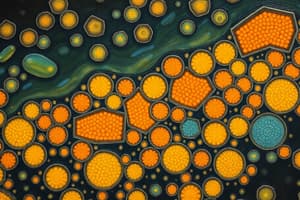Podcast
Questions and Answers
Which organelle is the primary site for protein synthesis and intermediary metabolism?
Which organelle is the primary site for protein synthesis and intermediary metabolism?
- Cytosol (correct)
- Golgi Apparatus
- Endoplasmic Reticulum
- Mitochondria
What is the primary function of the endosomes within a cell?
What is the primary function of the endosomes within a cell?
- Sorting and recycling of endocytosed material (correct)
- Aerobic respiration
- Protein modification and sorting
- Intracellular digestion
Which of the following organelles is responsible for oxidative reactions and the breakdown of long-chain fatty acids?
Which of the following organelles is responsible for oxidative reactions and the breakdown of long-chain fatty acids?
- Lysosomes
- Peroxisomes (correct)
- Mitochondria
- Endoplasmic Reticulum
Which transport mechanism involves the movement of cargo between topologically equivalent spaces without crossing a membrane?
Which transport mechanism involves the movement of cargo between topologically equivalent spaces without crossing a membrane?
What distinguishes topologically equivalent compartments from others within a cell?
What distinguishes topologically equivalent compartments from others within a cell?
Which type of sorting signal directs proteins from the cytosol to specific organelles like the ER or mitochondria?
Which type of sorting signal directs proteins from the cytosol to specific organelles like the ER or mitochondria?
What is the role of signal patches in protein sorting?
What is the role of signal patches in protein sorting?
Which of the following is NOT a component of the nuclear envelope?
Which of the following is NOT a component of the nuclear envelope?
Which component of the nuclear envelope is continuous with the endoplasmic reticulum?
Which component of the nuclear envelope is continuous with the endoplasmic reticulum?
What is the function of nuclear pore complexes (NPCs)?
What is the function of nuclear pore complexes (NPCs)?
What type of transport occurs through nuclear pore complexes for small molecules (
What type of transport occurs through nuclear pore complexes for small molecules (
Which of the following statements accurately describes the movement of molecules between the cytosol and the nucleus?
Which of the following statements accurately describes the movement of molecules between the cytosol and the nucleus?
What is the role of the nuclear lamina?
What is the role of the nuclear lamina?
How does transmembrane transport differ from gated transport?
How does transmembrane transport differ from gated transport?
Which organelle sorts and recycles endocytosed material?
Which organelle sorts and recycles endocytosed material?
What distinguishes signal peptides from signal patches?
What distinguishes signal peptides from signal patches?
What is the primary function of the lysosomes?
What is the primary function of the lysosomes?
Which of the following organelles is NOT involved in protein modification and sorting?
Which of the following organelles is NOT involved in protein modification and sorting?
If a protein is destined for the mitochondrial matrix, where would you expect its signal sequence to direct it initially?
If a protein is destined for the mitochondrial matrix, where would you expect its signal sequence to direct it initially?
How do proteins enter the endoplasmic reticulum (ER) lumen?
How do proteins enter the endoplasmic reticulum (ER) lumen?
Which of the following processes primarily occurs in the Golgi apparatus?
Which of the following processes primarily occurs in the Golgi apparatus?
What is the consequence of a mutation that disrupts a signal peptide on a protein normally targeted to the ER?
What is the consequence of a mutation that disrupts a signal peptide on a protein normally targeted to the ER?
In vesicular transport, how do vesicles recognize and fuse with their target membrane?
In vesicular transport, how do vesicles recognize and fuse with their target membrane?
How does a protein destined for the lysosome acquire its specific targeting signal in the Golgi?
How does a protein destined for the lysosome acquire its specific targeting signal in the Golgi?
What is the function of the outer nuclear membrane's ribosomes?
What is the function of the outer nuclear membrane's ribosomes?
Which of the following describes the correct order of compartments a protein might encounter if it is synthesized in the ER and ultimately functions in the lysosome?
Which of the following describes the correct order of compartments a protein might encounter if it is synthesized in the ER and ultimately functions in the lysosome?
How does the cell ensure that proteins targeted to the ER are translocated into the ER lumen rather than remaining embedded in the ER membrane?
How does the cell ensure that proteins targeted to the ER are translocated into the ER lumen rather than remaining embedded in the ER membrane?
What is the significance of protein glycosylation in the Golgi apparatus?
What is the significance of protein glycosylation in the Golgi apparatus?
Which of the following mechanisms is NOT directly involved in protein sorting?
Which of the following mechanisms is NOT directly involved in protein sorting?
Flashcards
Nucleus
Nucleus
Site of DNA and RNA synthesis within eukaryotic cells.
Cytosol
Cytosol
Location of protein synthesis and intermediary metabolism.
Endoplasmic Reticulum (ER)
Endoplasmic Reticulum (ER)
Organelle involved in protein modification and sorting, also lipid synthesis.
Golgi Apparatus
Golgi Apparatus
Signup and view all the flashcards
Endosomes
Endosomes
Signup and view all the flashcards
Lysosomes
Lysosomes
Signup and view all the flashcards
Mitochondria
Mitochondria
Signup and view all the flashcards
Peroxisomes
Peroxisomes
Signup and view all the flashcards
Gated Transport
Gated Transport
Signup and view all the flashcards
Transmembrane Transport
Transmembrane Transport
Signup and view all the flashcards
Vesicular Transport
Vesicular Transport
Signup and view all the flashcards
Topologically Equivalent Compartments
Topologically Equivalent Compartments
Signup and view all the flashcards
Signal Peptides
Signal Peptides
Signup and view all the flashcards
Signal Patches
Signal Patches
Signup and view all the flashcards
Inner Nuclear Membrane
Inner Nuclear Membrane
Signup and view all the flashcards
Outer Nuclear Membrane
Outer Nuclear Membrane
Signup and view all the flashcards
Nuclear Pore Complexes (NPCs)
Nuclear Pore Complexes (NPCs)
Signup and view all the flashcards
Study Notes
- Organelles have distinct functions within the cell.
- The nucleus is responsible for DNA and RNA synthesis.
- The cytosol is the site of protein synthesis and intermediary metabolism.
- The endoplasmic reticulum (ER) is involved in protein modification and sorting.
- The Golgi apparatus also functions in protein modification and sorting.
- Endosomes are key for sorting and recycling endocytosed materials.
- Lysosomes facilitate intracellular digestion.
- Mitochondria are the site of aerobic respiration.
- Peroxisomes carry out oxidative reactions and break down long-chain fatty acids.
Mechanisms for Sorting Proteins
- Gated transport moves proteins and RNA between the cytosol and nucleus via nuclear pore complexes.
- Transmembrane transport moves specific proteins across membranes.
- Vesicular transport moves cargo between topologically equivalent spaces without crossing a membrane.
Topologically Equivalent Compartments
- Compartments are topologically equivalent if molecules can move between them without crossing a membrane.
- The ER and Golgi apparatus are topologically equivalent.
Types of Sorting Signals
- Signal peptides direct proteins from the cytosol to specific compartments like the ER or mitochondria.
- Signal patches direct enzymes and proteins to the correct compartments, such as from the Golgi to lysosomes.
Components of the Nuclear Envelope
- The inner nuclear membrane binds to chromosomes and the nuclear lamina.
- The outer nuclear membrane is continuous with the ER and is studded with ribosomes.
- Nuclear pore complexes (NPCs) allow bidirectional movement of proteins and RNA.
Function of Nuclear Pore Complex
- Nuclear pore complexes allow small molecules to pass through passively.
Studying That Suits You
Use AI to generate personalized quizzes and flashcards to suit your learning preferences.




